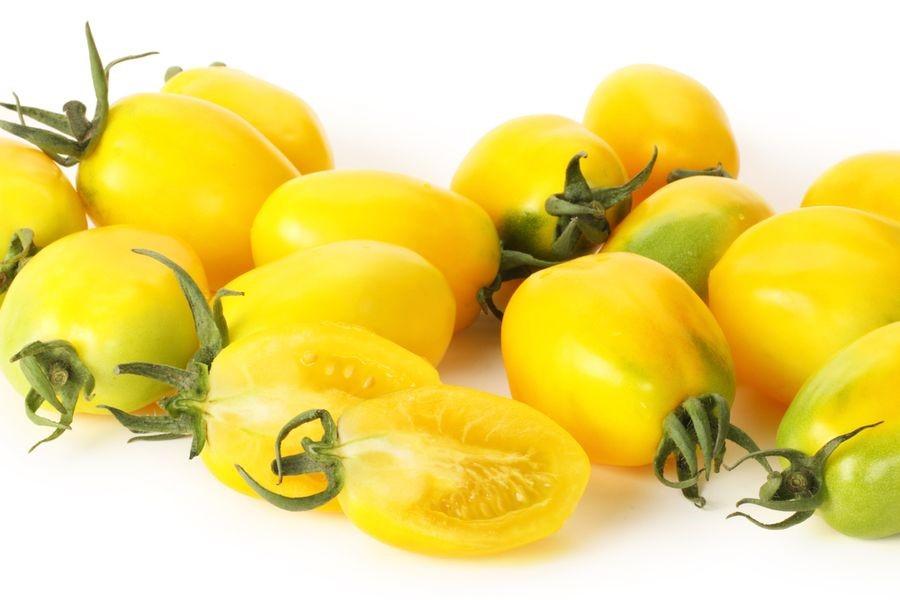Content
The Yellow Date tomato has become widespread due to its sweetish taste, meatiness and a fairly simple growing process. You can learn more about the variety in order to understand what features it has and what requirements for planting and care are below.
Breeding history
The Yellow Date tomato is considered one of the most juicy and tasty among a wide variety of varieties. The variety is characterized by high tomato yields and resistance to long-term transportation.

Tomato Date yellow is a hybrid variety
The variety was obtained through hybridization. Bred by the Russian Ogorod company for promotion on the market. The tomato is characterized by rapid growth and versatility of use.
Description and characteristics of the tomato variety Date yellow
Before planting Yellow Date tomatoes on your plot, you should familiarize yourself with their features and characteristics.
Description of culture:
- Medium-sized bush with little foliage. It reaches a height of 90-150 cm. The growth type is semi-determinant.
- The fruits are yellow oval cherry, with a pointed end. Tomato weight – 20 g. 6-8 pcs are formed in a brush.
- The taste of the fruit is unusual: sweet, with notes of plum and raisins. There are honey notes in the aftertaste.
- The pulp is dense, juicy, and sugary when ripe.

The yellow date is a mid-season tomato.
Ripening and fruiting
Fruit ripening occurs in 125 days. Fruiting is long, which is an advantage of the variety for some gardeners. The tomato harvest will begin from mid-July until almost the end of autumn.
Tomato yield Date yellow
The yield of Yellow Date tomatoes is about 3 kg per square meter. The average harvest per bush is 1.5 kg. Yellow dates produce springy tomatoes with a rich lemon color. Cherry tomatoes, small in size.

The yield of yellow date tomato can be increased if you properly care for the plants
The variety is considered high-yielding.
Disease resistance
The yellow date perfectly tolerates the main diseases that affect tomatoes. It is extremely rare for late blight and other diseases. But this does not mean that preventive measures are not required.
If there are concerns about the risk of plant disease, it is worth using fungicides. An excellent option would be wood ash, which can be regularly added to irrigation water.
Growing regions
Yellow Date tomatoes are mainly grown in the southern regions, since the duration of the summer season there is much longer than in all other parts of the country. As a result, plant productivity increases.
In areas with cooler climates, the variety is grown in greenhouses or under film cover.
Methods of application
Yellow Date tomatoes can be used in a variety of ways due to its density and juiciness. It looks great in a variety of salads and complex dishes, and can also act as a decorative element on a plate. Tomatoes are also used as preparations for the winter (canning, freezing). Of course, the yellow date is also consumed fresh - it is full of vitamins, acids and microelements that have a positive effect on the condition of the body.
Advantages and disadvantages
The Yellow Date variety is a small-fruited variety. Therefore, bright tomatoes are often used to decorate dishes.

Canned tomatoes look attractive in assorted vegetables
Pros:
- high yield;
- long shelf life of the crop;
- excellent taste;
- thick skin and interesting shape, convenient for transportation;
- minimal risk of an allergic reaction when eating yellow fruits.
Minuses:
- low resistance to pests;
- When grown in unfavorable conditions, the variety produces a small harvest.
Planting dates and scheme
The yellow date is easy to plant, but in order to have a lot of berries, you should follow the instructions. The minimum distance between bushes is 70 centimeters. The rows can be located at a distance of 50 centimeters from each other.The size of adult bushes is relatively small, but being too close will cause fewer tomatoes on the side branches.
Pre-germination is carried out at home - seeds are planted around February-March. Two weeks before planting in open ground, the seedlings are hardened off.
Landing algorithm:
- Dig holes. The depth should be 20 cm. Peat is placed at the bottom and then filled with water.
- The plant is placed in the center of the hole. Covered with earth.
- After planting, the soil in the hole must be compacted.
- Water the plant with settled warm water at the rate of 1 liter for each seedling.

Tomatoes are planted on a cloudy day or in the evening.
Rules of care
The main requirement is to carry out abundant watering, especially during periods of flowering and crop formation. Before this, moderate watering, preferably with warm water at the root. You can use a drip irrigation system.
If necessary, loosen the ground and remove weeds. During periods of severe drought, mulching is carried out to retain moisture in the ground. To do this, you can use sawdust, peat, straw or covering material.
Fertilizing Yellow Date tomatoes is carried out once every two weeks. In this case, mineral fertilizers alternate with organic ones. During the period of fruit formation, potassium salts can be added to form larger and fleshier fruits.
Treatment against diseases and pests
Treatment against diseases is carried out using fungicides (Phytophtorin, Planriz, Baktofit), as well as folk remedies. Among the traditional methods, spraying with iodine serum and watering with wood ash have proven themselves to be effective.
If the yellow date is resistant to diseases, then an invasion of pests can cause a serious decrease in yield. For treatment, you can use folk remedies or insecticides (Skor, Kaptan).
Conclusion
Yellow Date tomato is a popular hybrid variety. It has a simple cultivation scheme and requires a minimum amount of time and effort during care, therefore it is in high demand in the market. Tomatoes are distinguished by their juiciness, rich taste and ability to adapt to the environment.
Reviews from gardeners about the Yellow Date tomato








